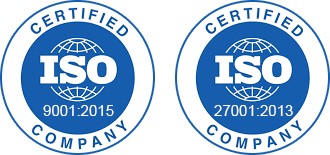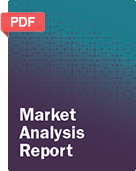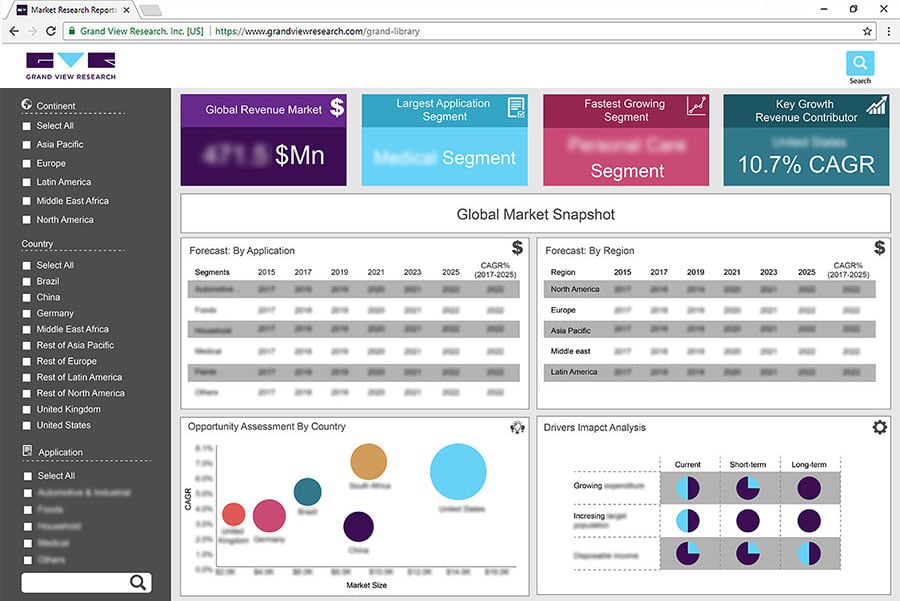- Home
- »
- Pharmaceuticals
- »
-
Rosacea Treatment Market Size & Share, Industry Report, 2019-2025GVR Report cover
![Rosacea Treatment Market Size, Share & Trends Report]()
Rosacea Treatment Market Size, Share & Trends Analysis Report By Drug Class (Alpha Agonists, Antibiotics, Retinoids, Corticosteroids), By Mode of Administration (Topical, Oral), By Region, And Segment Forecasts, 2019 - 2025
- Report ID: GVR-2-68038-739-1
- Number of Report Pages: 83
- Format: PDF, Horizon Databook
- Historical Range: 2014 - 2016
- Forecast Period: 2018 - 2025
- Industry: Healthcare
Industry Insights
The global rosacea treatment market size was valued at USD 1.5 billion in 2017. It is anticipated to register a CAGR of 6.8% from 2019 to 2025. The market is consolidated in nature. Proactive government initiatives, advanced formulations, and high disease prevalence are some factors contributing to market growth.
Rosacea affects more than 400 million people worldwide, yet it remains an underdiagnosed condition. The global disease incidence is estimated to be 5%. People with light/fair skin, especially women, tend to be more prone to this condition. The disease is often misdiagnosed as acne due to several similarities in the presentation.
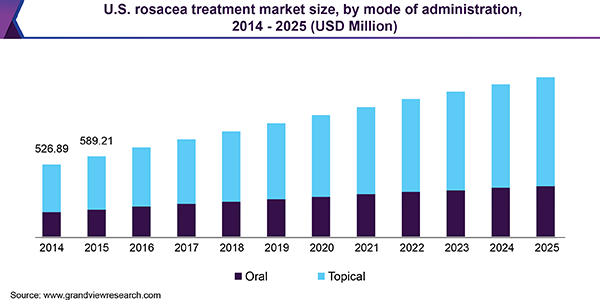
The market faces high generic penetration, due to multiple patent expiries and off-label usage of medicines. Several acne medications, such as benzoyl peroxide, azelaic acid, and sulfur agents are used for the treatment of rosacea. Although the available treatments are majorly topical or oral, there is a significant paradigm shift as treatment options are increasingly inclined towards combination therapies for more effective results.
Rhofade, Mirvaso, Oracea, Finacea, Soolantra, and Noritate are some of the key revenue generators for this market. Although generic products pose intense competition, the market is projected to be driven by the impending launch of promising pipeline candidates, such as FMX-103 and Epsolay (VERED).
Drug Class Insights
Antibiotics are, generally, used as the first-line of therapy. Metronidazole is one of the most commonly prescribed antibiotic for rosacea. Erythromycin, clindamycin, clarithromycin, doxycycline, minocycline, and tetracycline are some of the other antibiotics used in the treatment of rosacea. In addition, sulfacetamide products and azelaic acid are also recommended in the first-line of treatment. Immunosuppressants, such as tacrolimus, are used to reduce inflammation and itching by suppressing cytokines.
Alpha agonists is the fastest growing drug class, with an estimated CAGR of more than 8% during the forecast period. The class has two key revenue generators, namely, Mirvaso and Rhofade. Both the products are indicated for rosacea-associated erythema.
Mode of Administration Insights
Topical drugs remain the mainstay for rosacea treatment, capturing more than 65% market share in 2017. Topical drugs are generally prescribed as first-line treatments and are preferred over other options on grounds of convenience and better results.
Oral and topical medications may be used in combination, on a case-to-case basis and depending upon disease severity. In such cases, oral therapy is withdrawn gradually and topicals are continued as maintenance therapy. However, oral therapy is maintained for ocular rosacea.
Regional Insights
North America accounted for nearly 50% market share in 2017 and is anticipated to continue leading through the forecast period. Several factors such as growing consumer awareness, new drug development, technological advancements for accurate diagnosis, exposure to environmental triggers, and increasing number of drug approvals are collectively driving the regional growth.
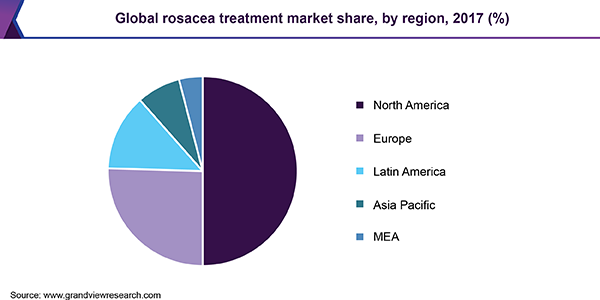
The Asia Pacific rosacea treatment market is estimated to showcase the fastest growth over the forecast period. The region is driven chiefly by improving economic state and a growing emphasis on healthcare infrastructure. Adoption of superior technologies, and rise in consumer awareness and disposable income are major propellers in this region.
Rosacea Treatment Market Share Insights
Some of the key players include Allergan Plc; Bayer Schering AG; Bausch Health Companies Inc.; and Nestlé S.A. The market is driven by the anticipated launch of promising pipeline candidates from Foamix Pharamceuticals and Sol-Gel Technologies.
Nestlé S.A. (Galderma division) led the competitive space, and is forecasted to continue holding the largest market share, supported by the strong commercial performances of Mirvaso, Oracea, MetroGel, and Soolantra. Furthermore, Rhofade from Allergan and Noritate from Bausch are significant revenue contributors.
Report Scope
Attribute
Details
Base year for estimation
2017
Actual estimates/Historical data
2014 - 2016
Forecast period
2018 - 2025
Market representation
Revenue in USD Million and CAGR from 2017 to 2025
Regional scope
North America, Europe, Latin America, Asia Pacific, Middle East & Africa
Country scope
U.S., Canada, Germany, U.K., Brazil, Mexico, Japan, China, India, South Africa
Report coverage
Revenue forecast, competitive landscape, growth factors, and trends
15% free customization scope (equivalent to 5 analysts working days)
If you need specific information, which is not currently within the scope of the report, we will provide it to you as a part of customization
Segments Covered in the ReportThis report forecasts revenue growth at global, regional, and country levels and provides an analysis of the latest industry trends in each of the sub-segments from 2014 to 2025. For the purpose of this study, Grand View Research has segmented the global rosacea treatment market report based on drug class, mode of administration, and region:
-
Drug Class Outlook (Revenue, USD Million, 2014 - 2025)
-
Antibiotics
-
Alpha agonists
-
Retinoids
-
Corticosteroids
-
Immunosuppressants
-
Antihypertensive Agents
-
Others
-
-
Mode Of Administration Outlook (Revenue, USD Million, 2014 - 2025)
-
Topical
-
Oral
-
-
Regional Outlook (Revenue, USD Million, 2014 - 2025)
-
North America
-
The U.S.
-
Canada
-
-
Europe
-
The U.K.
-
Germany
-
-
Latin America
-
Brazil
-
Mexico
-
-
Asia Pacific
-
Japan
-
China
-
India
-
-
Middle East & Africa
-
South Africa
-
-
Share this report with your colleague or friend.
![gvr icn]()
NEED A CUSTOM REPORT?
We can customize every report - free of charge - including purchasing stand-alone sections or country-level reports, as well as offer affordable discounts for start-ups & universities. Contact us now
![Certified Icon]()
We are GDPR and CCPA compliant! Your transaction & personal information is safe and secure. For more details, please read our privacy policy.
We are committed towards customer satisfaction, and quality service.
"The quality of research they have done for us has been excellent."
